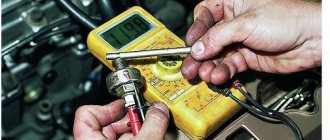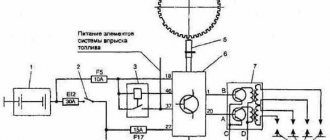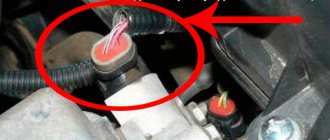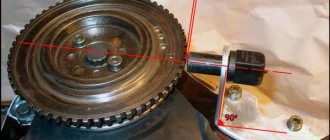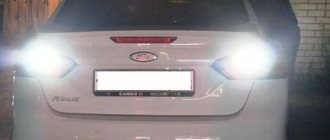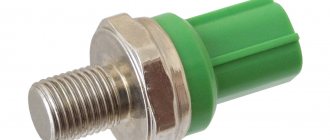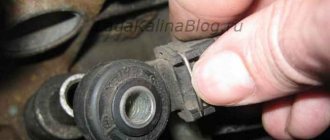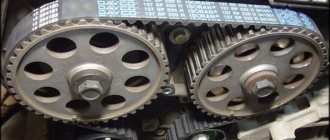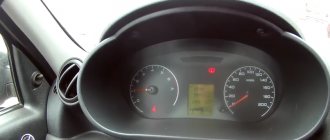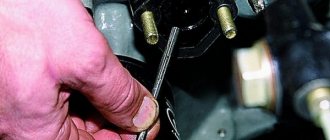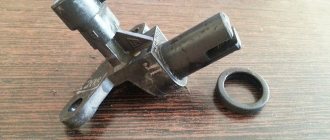A device designed to detect detonation in a car is part of the engine control system. Absolutely all vehicles are equipped with these elements, including the VAZ 2115.
The knock sensor is used to monitor the stable operation of the engine. If there is some kind of malfunction, it starts knocking.
The sensor should warn of a possible electrical impulse that occurs during ignition in the power unit. The fuel may detonate in the cylinder, which is also indicated by this element. The sensor is similar in its action to a piezoelectric element. The size of the sensor is small, no larger than a matchbox.
What is the knock sensor responsible for and what does it consist of?
The knock sensor monitors the process of turning on the car engine and ensures its normal functioning.
The device consists of the following parts:
- Vibration plates.
- Wires that are used to supply a signal.
- Braids.
When knocking, the sensor emits a signal of a certain voltage, which is then sent to a monitoring device that processes it. The controller sends a signal to the ignition timing. This impulse depends on the strength of the received signal. The process occurs very quickly, within a fraction of seconds, so it is not noticeable for observation.
The knock sensor on the VAZ 2115 is located in the engine block, between the second and third cylinders. The sensor can be one- or two-contact. It depends on the car engine.
Observations show that the sensor is a fairly reliable device that can function for several years. But, like any device, it can fail and begin to show signs of malfunction.
Knock sensors for the VAZ-2115 are available in two variations:
- Resonant in the shape of a barrel.
- Broadband, tablet-like.
Installation of a knock sensor can only be done when the car has an automatic ignition system. Otherwise, it cannot be installed. Carburetor models are not equipped with such elements. Typically, the price of a sensor may vary depending on the manufacturer.
Knock sensorCost, in rubles
| Knock sensor VAZ 2110/2115/GAZ 406 Startvolt VS-KS 0110 | 200 rub. |
| Knock sensor for VAZ 2110, 2115, GAZ 406 VSKS0110 Startvolt VSKS0110 | 350 rub. |
| Knock sensor for VAZ 2110 2115 GAZ 406 (vs-ks 0110) Startvolt art. vs-ks-0110 | 250 rub. |
| Knock sensor for VAZ 2110, 2115, GAZ 406 VSKS0110 | 650 rub. |
If the sensor urgently needs to be replaced, then you need to purchase and install it as soon as possible. All car enthusiasts are very concerned about the cost of purchasing new elements. It is small and, as a rule, depends on the quality and country of origin.
Checking and replacing the knock sensor
Failure of the knock sensor on a VAZ-2115 can occur for a number of the following reasons, including:
- Damage to the device itself.
- Broken signal wire or shielding braid.
- There is a malfunction in the engine control unit.
You can get an idea of the stable operation of this device by looking at the car’s instrument panel. There is a “Check-Engine” sign on the panel. If it does not light up, then the device is functioning normally. When there is a breakdown, the icon on the dashboard lights up. This means that the device does not work and needs to be replaced.
There are times when a sensor malfunction message is not received on the dashboard. This situation is possible when the electrical circuit breaks. Problems associated with the sensor can be seen by an increase in fuel consumption. If it is faulty, the indicator increases.
In this case, first of all, you need to check the integrity of all connection wires and contacts and, if necessary, clean them.
There are also several errors that appear during computer diagnostics of a car and which indicate a failure of the knock sensor:
- Error code 0325 indicates that there is a break in the electrical circuit of the external part of the sensor.
- Error code 0326, as well as 0327, indicates that a low pulse is being received from the sensor.
- Error number 0328 indicates that the signal level from the sensor exceeds the norm.
To check the functionality of the knock sensor, you must perform the following steps:
- Prepare the necessary tools: a wrench for tightening and unscrewing parts located in hard-to-reach places by 13 or 22 mm, a screwdriver, a voltmeter.
- Remove the sensor from its installation location.
- Set the voltmeter to operate within 200 MV.
- Connect the sensor to a voltmeter.
- Tap the body of the part with a hard object.
- Observe changes in the device readings, depending on the frequency of blows to the body.
- If the information from the sensor does not change when tapping, then the sensor is faulty and needs to be replaced.
Practice shows that you should purchase the necessary equipment from a trusted supplier. If the product is of poor quality, then other elements that are closely related to it may fail. If in doubt, the sensor can be diagnosed at a service station using special equipment.
A breakdown of the knock sensor is dangerous for the operation of the car engine, as the fuel begins to detonate. To replace the knock sensor, you need to unscrew it using a wrench, disconnect the wires from it and install a new sensor.
Thus, we can conclude that the knock sensor on the VAZ-2115 is a necessary element for the stable operation of the car. It is important that the sensor is always in good condition, since only in this case can it promptly report possible breakdowns in the system.
In addition, this car, like any other, needs timely diagnostics. It is thanks to this that any breakdown can be prevented, which will save unexpected financial costs.
An easy way to diagnose a knock sensor
To diagnose the sensor, you can drive to a car service center or perform the procedure yourself using measuring instruments. For example, the easiest way to troubleshoot problems is as follows:
- dismantle the sensor and connect a multimeter to it (you can use a voltmeter). The circuit is simple - the electrodes of the measuring device should be located at the output contacts of the sensitive element;
- Using a screwdriver or other tool, lightly tap the device body with varying amounts of force;
- On the multimeter display we look to see if the readings change when tapping on the sensor. If yes, then the device is working correctly. Otherwise, it should be replaced, since it cannot be repaired.
The knock sensor plays a very important role in the design of the VAZ-2115 car - it makes it possible to promptly recognize problems with the engine and adjust the ignition system to eliminate them. Therefore, it is very important to maintain it in good condition, and in the event of a breakdown, immediately replace the motor to prevent engine failure.
Replacing the knock sensor VAZ 21124
A knock sensor is a device that determines the moment of micro-explosions (detonations) in a car engine. Included in the electronic control system of an engine equipped with an injection system.
VAZ 2115 knock sensor signs of malfunction
Each car includes a large number of different sensors in its design. These devices are necessary to monitor the status of the main components of the car and transmit information to the electronic control unit. Based on the received data, the ECU adjusts the operation of a particular system and makes appropriate changes if necessary.
How does the sensor work and why is it needed?
The operation of the mechanism is based on the principle of a piezoelectric element. This means that if vibration of a different nature occurs in the engine cylinder, a signal will be transmitted to the ECU using electronic pulses. In turn, the final element in this chain will make changes to the operation of the ignition angle.
The fundamental difference between a resonant type device is that it is capable of capturing only noise at the detonation frequency.
The broadband mechanism is superior to its counterpart in that it has a wider range of capabilities. Such a sensor is capable of capturing noise of various frequencies, which undoubtedly gives the vehicle system additional stability.
The devices operate on different principles, therefore, if the resonant sensor breaks down, it cannot be replaced with a broadband one. The situation is similar in the opposite case. If there is an urgent need to replace or change the operating principle of the mechanism, you will have to purchase a new control unit.
Main symptoms of a malfunction
If the VAZ-2114 knock sensor begins to function incorrectly, then in most cases the driver will be able to notice a flashing Check Engine light on the dashboard. At the same time, it is easy to notice a malfunction by the very behavior of the car. The car accelerates poorly, does not overtake, and “chokes” when going uphill. The engine is unstable and shows obvious signs of failure. Other symptoms include:
- frequent overheating of the motor;
- when you press the gas pedal sharply, a detonation knock is clearly audible;
- The on-board computer generates an error, the interpretation of which indicates a sensor malfunction.
Detonation knocks often occur due to low-quality gasoline. If all of the above symptoms are present, it is best to conduct a full computer diagnostic of the car. Monitoring will allow you to determine at which stages of engine operation the worst performance is observed, and computer diagnostics will also allow you to find out the error code of the knock sensor.
Diagnostics can detect faults such as an open circuit, signal level exceeding or its value being too low.
If the diagnostics determines that the knock sensor is faulty, you still need to make sure that the device is not functioning correctly.
see also
Checking DD at home
How to check the knock sensor of a VAZ 2114 at home? It is possible to determine the performance of the mechanism using an ohmmeter or digital voltmeter. The first allows you to determine the resistance, and the second - the voltage between the contacts. A correctly functioning VAZ 2114 knock sensor has an almost infinite resistance. If this indicator is completely absent, then the mechanism must be replaced.
How to tell if the knock sensor is not working
- The Check Engine light comes on immediately when starting the engine, when driving downhill or accelerating;
- the engine starts to misfire for no reason;
- the car accelerates poorly, its dynamic characteristics deteriorate significantly.
All these symptoms can be considered individually or in combination. If at least one of them appears, it is better to first diagnose the sensor so as not to disassemble the engine for nothing.
In addition, diagnostic work is also necessary if the on-board computer displays one of the following knock sensor error codes:
- This code does not indicate a problem with the high voltage wires;
- Most likely, the error code means oxidation of the contacts, which should be carefully cleaned to restore normal operation of the device. The problem may also be caused by a break in the wiring that supplies current to the knock sensor;
- 0326-0327. These codes indicate that the signals from the sensor to the controller are too weak. The main reasons are the same oxidation of contacts or weak fixation of the sensitive element.
Knock sensor for VAZ 2115 - diagnostics, repair, where is it located
Now you will find out what it’s like to look for something without knowing what!!!
Well, I'm tired of this problem with the loss of engine speed during acceleration. The car doesn't drive and that's it. And this car is Kalina 1, 8 valves, 2012. The knock sensor error P0327 kept popping up. Open circuit or failure of the DD sensor.
At first, I often climbed under the hood and removed the chip, slightly bent the contacts on the sensor and the error seemed to disappear for a while. Then she appeared again.
But when driving calmly, you practically don’t notice any dips in the engine’s operation. And my driving style is that of a pensioner. On a station wagon you don’t want to stomp on the throttle.
But recently, I very often began to run into the reluctance of my white barrel to accelerate as intended by the manufacturer. And one fine sunny autumn day I went to the store to buy a knock sensor, deciding that it was in it that the problem was hidden, namely in its contact group.
And so the sensor was purchased at the nearest auto parts store for some 165 rubles. It immediately seemed to me that this price was very low for such a part. Even on the Internet the prices were almost twice as high.
Comparing the old and new sensors. The contacts of the new sensor are very crooked. On the new 4B - on the old 2B.
I installed a new sensor and went for a ride in the car on business.
How did she go... Wow. I was literally tearing it out from under myself!
Yes, self-hypnosis is a great thing.
I arrived home to the hut, looked at the mistakes and my hands sank to the very ground from grief. Error again. Once again the knock sensor was lost and the ECU couldn't find it. Sadness.
But the morning is wiser than the evening. And the next day I decided to check the two sensors for their performance on a multimeter.
It turns out that if you connect the multimeter probes in the constant voltage position at around 200 mV to the sensor contacts. And squeeze the sensor with your fingers, then voltage surges will appear on the multimeter. These are the very impulses that must enter the ECU to adjust the ignition angle.
And to my surprise, the new sensor was silent. No matter how I squeezed him or pounded him, simulating the operation of the engine, he remained silent. The multimeter showed 000. But the old sensor decided to show what it was capable of and in all its glory gave out everything that was required of it.
Unfortunately, I didn’t think of filming how silent the new sensor was. I took it to the store and asked to exchange it for a working one. But it turned out that all the sensors that they tried to give me as replacements were dummies. THOSE. they also did not respond to pressure. There were no impulses.
The seller, to put it mildly, was taken aback by this situation with the sensors, because the 6 sensors from the counter were dummies. Or maybe the whole party.
I was asked to check an expensive Bosh DD for 1000 rubles. He turned out to be completely fine. But I refused to take it, because I decided that the old friend was better than the new two.
Arriving at the car, I reached into the sensor wiring. I took the chip off the DD. I took the ECU out from under the glove compartment.
ITELMA 11183-1411020-52
I removed two connectors from it. I found on the Internet which contacts receive signals from the DD. These are A3 (from 1 DD contact) and B3 (from 2 DD contacts).
What are the effects of knock sensor malfunctions?
Is it possible to drive with a faulty knock sensor? This question interests motorists who are encountering this problem for the first time. In general terms, the answer to this question can be formulated as follows: in the short term, you can use the car, but at the earliest possible opportunity, it is necessary to carry out appropriate diagnostics and fix the problem.
Indeed, according to the principle of operation of the ECU, when a malfunction of the fuel knock sensor occurs, a late ignition is automatically set to prevent damage to the piston group parts if real detonation occurs during combustion of the fuel mixture. As a result, fuel consumption rises and dynamics drop , which will become especially noticeable as the speed increases.
How to check the knock sensor of a VAZ 2114-2115 at home?
A device designed to detect detonation in a car is part of the engine control system. Absolutely all vehicles are equipped with these elements, including the VAZ 2115.
The knock sensor is used to monitor the stable operation of the engine. If there is some kind of malfunction, it starts knocking.
The sensor should warn of a possible electrical impulse that occurs during ignition in the power unit. The fuel may detonate in the cylinder, which is also indicated by this element. The sensor is similar in its action to a piezoelectric element. The size of the sensor is small, no larger than a matchbox.
Where is the knock sensor located?
In order to find the DD you need to open the hood and look at the engine. Between the second and third cylinders there is a knock sensor unit. If the engine is 16-valve, then due to the larger connector, the sensor may be less noticeable, although it is located in the same place.
There are two types of knock sensors: broadband and resonant. Resonant sensors can only detect a certain detonation purity and are shaped like a barrel. A wideband sensor, using noise, detects the entire detonation band as a whole and is more similar in shape to a tablet. Mostly broadband ones are used in cars; their cost is approximately 200–400 rubles.
Resonant ones are used much less frequently and finding them in stores can be a big problem; the cost of such sensors reaches 3,000 rubles.
List of errors DD VAZ 2114
- Error code 0325 – the wiring supplying power to the knock sensor has broken. This error can be caused by oxidized DD contacts. Contacts need cleaning. In addition, problems with the timing belt can lead to it, so it also needs to be checked (perhaps it has jumped a couple of teeth, then you need to set everything to the marks).
- Error code 0328 - high-voltage wires are faulty. However, in this case, again, there is a possibility of the timing belt jumping.
- Error code 0326, 0327 – weak signal from the knock sensor. To eliminate this problem, you need to clean the connection contacts of the VAZ 2114 DD. Also, errors can be caused by weak tightening of the sensor.
Signs of a malfunctioning knock sensor
Of course, to detect a problem, it is best to go to a service center, but to identify a malfunction of the knock sensor, it is not necessary to carry out a full diagnosis. Some external factors can indicate a breakdown and inform the driver about the malfunction even before diagnosis:
- Increased fuel consumption;
- The “check” light on the car is constantly on, or periodically during acceleration;
- The internal combustion engine begins to stall;
- When accelerating, you feel that the car is losing speed;
- The engine periodically overheats due to incorrectly set ignition;
- When adding gas, a knocking sound is heard in the car engine;
- During diagnostics, a knock sensor error is displayed.
When an error occurs, a special code is displayed, and depending on the error code, you can determine the extent of the problem and begin to resolve it.
Code 0325 means that the contact is not being made, and the wires may have broken. Wiring breaks very rarely, so most often you just need to clean the contacts. If it doesn’t help, then you can check the timing belt, and if it comes off, return it to its place according to the marks.
Code 0326 (0327) - means that the contact is present, but the signal is received very poorly. It is necessary to clean the contacts and then check how well the sensor is secured. If necessary, tighten the tension.
Code 0328 - the problem is a faulty wire, there is no contact, or the timing belt may come off.
Functionality check
If typical signs of a malfunction are detected, it is necessary to check the operation of the DD. To do this you will need a regular screwdriver and a tester.
A tester, also known as a multimeter, can be purchased at any automotive store. It is inexpensive, about 500-600 rubles, and will come in handy in the garage many times (it is used to check all systems and devices of the car that consume electricity), so there is no need to skimp on the device.
The DD functionality check is performed as follows:
- We dismantle the sensor (how to do this is written in the next section of the article);
- We connect the multimeter probes to the DD contacts (if it is two-contact), if it is single-contact, the first probe to the wire, the second to the device body;
- We switch the tester to voltmeter mode and set the upper measurement limit to 200 mV;
- Tap a screwdriver (or any metal object) on the sensor body;
- If the device is working properly, the multimeter will show voltage surges, the magnitude of which should be directly proportional to the force of the impact (this indicates that the device retains the ability to convert mechanical energy into alternating current). If the multimeter readings do not change, the DD does not work.
Article on the topic: Checking the operation of the generator on a VAZ 2114: how many volts (V) it produces
If you find out that the device itself is working properly, but DD errors are displayed on the on-board computer or the car is not working as it should, the problem is most likely in the oxidized contacts of the sensor. Treat them with WD-40 or a similar solvent, install the DD in place and check the result. If that doesn't help, replace the knock sensor.
How to check the knock sensor
Only a tested and inoperative knock sensor needs to be replaced. Therefore, it is necessary to check before replacing. You don’t need any special knowledge to do this, the main thing is to stock up on a multimeter.
We connect the multimeter and close the contacts. If it is working properly, the multimeter will display infinite numbers.
If the sensor is faulty, the values may not be displayed or may be to the 10th power.
Before checking the DD, you need to understand whether it is single-contact or two-contact.
How to remove a headlight on a VAZ 2114, excluding accidental mistakes
The check is carried out with the ignition off. When using a two-pin sensor, it must be disconnected from the battery.
How to check, step by step instructions:
- Take a multimeter and switch to 200 mV;
- After this, we close the probes on the contacts, regardless of where the plus and minus are located;
- We find a solid object and, when connecting the multimeter, hit the sensor;
- We look at the values that are displayed. 20 to 40 mV are normal values and may vary depending on the strength of the impact.
If the multimeter does not show the correct value, then it is necessary to replace the non-working device.
Description of the phase sensor
First, let's look at the installation location, purpose, and design features of the DF.
Location, purpose and device
In VAZ 2114 and 2115 cars, the phase sensor is a device used to obtain information about the operation of the power unit and further transmit this data to the control unit.
Sensors, their purposes and malfunctions
Let's now talk in more detail about each of the sensors, let's look at where they are and what they look like.
Idle speed (IAC)
The device is located in the throttle assembly. It is a small induction coil with a needle inside. Depending on the controller readings, one or another voltage is applied to the coil winding and the needle extends a certain distance into the throttle pipe, regulating the air supply. With this, the idle speed is adjusted.
Idle speed control
There is no indicator responsible for this sensor. Therefore, if this node fails, then this can be understood by the following “symptoms”:
- The engine stalls at idle or when changing speed;
- “Floating”, unstable idle speed;
- When turning on a cold engine, there is no increased speed.
To replace the sensor, you must turn off the power to the machine's wiring, completely disconnect the throttle assembly, and then remove the sensor from it, after first disconnecting the terminals that supply electricity to it. In place of the old sensor, you need to install a new device and place the throttle assembly in place.
Detonation (DD)
The knock sensor is located between the cylinders on a car engine and reacts when the fuel detonates inside the cylinder. In essence, it is a piezoelectric element. When gasoline detonates, the sensor converts the resulting vibrations into electricity. Current is supplied to the on-board computer and signals a fuel explosion. After this, the ignition timing is automatically adjusted.
Knock sensor
If this type of sensor breaks down, the fuel begins to detonate in the engine. To check the device for functionality, you need to disconnect it using a key from its mounting location, connect it to a voltmeter and knock on it. If voltage was applied to the voltmeter, then the unit is working; if not, it is faulty.
To replace a device, you need to unscrew it from the seat using a key, disconnect the terminals from it and install a new device.
Oxygen (Lambda probe)
The oxygen sensor, also known as a lambda probe, is installed on the exhaust pipe close to the cylinders. It measures the amount of oxygen contained in exhaust gases and the environment. It only works when the engine is on, as it must be heated to function. When oxygen molecules hit the sensor, electricity is generated, which is supplied to the control unit. The on-board computer, based on sensor readings, regulates the supply of oxygen to the engine cylinders.
Lambda probe
If the sensor fails, the following consequences occur:
- Unstable gasoline consumption: sometimes more, sometimes less;
- “Walking” speed at idle;
- A sharp drop in power when accelerating.
In order to replace this sensor, you need to turn off the power to the car, disconnect the wires going to the device, unscrew it with a key, and then put a new one in its place.
Crankshaft position (CPCV)
This sensor regulates the ignition of the combustible mixture in the cylinders depending on the position of the crankshaft. This position is determined by reading electromagnetic pulses from the toothed pulley of the electric generator. The sensor itself is located in close proximity to it.
Crankshaft position sensor
Symptoms of device failure may include:
- Idle speed instability;
- “Floating” speed;
- Power drop;
- Problems when turning on the engine.
At home, the performance of the sensor can be tested using a multimeter in ohmmeter mode. The resistance at the device contacts should be from 500 to 700 Ohms. If it differs greatly from these values, the sensor is faulty.
To replace the sensor, you need to turn off the power to the car's wiring, disconnect the battery, disconnect the electrical contacts from the device, and then unscrew the mounting bolt, remove the sensor and install a new one.
Camshaft position (CPRV)
This sensor, called DPRV for short, reads data from the camshaft. This happens with the help of a special gear installed on the shaft, on which two teeth are missing. This sensor is needed to adjust the ignition angle by the car’s on-board computer.
Camshaft position sensor
If this device breaks down, idling becomes unstable and the engine's fuel consumption increases.
The sensor is located to the left of the engine, near the air filter. Before replacing it, you need to de-energize the vehicle's wiring. Then you need to unscrew the sensor fixing bolt, remove it, disconnect the contact terminal, and then install a new device.
Coolant temperature (CLT)
The coolant temperature sensor (abbreviated as DTOZH) is located between the cylinder head and the thermostat. It measures the coolant temperature and transmits the resulting readings to the on-board computer. Based on this information, the rotation speed of the cooling fan is automatically adjusted, as well as the intensity of the pump pumping up antifreeze.
Signs of damage may include:
- Spontaneous fan switching on even when the engine is cold;
- Increased fuel consumption;
- Difficulty starting the engine “hot”;
- Motor overheating;
- The indicator readings on the dashboard do not correspond to the actual engine temperature.
You can check the sensor by lowering it into heated coolant and measuring the resistance at the contacts using a multimeter. Before this, the temperature of the liquid must be measured with a thermometer, and then the readings of the thermometer and ohmmeter must be compared. If at a temperature of 50-60 degrees the resistance of the sensor is 600-700 Ohms, it is working; if it differs significantly from these figures, the device is faulty.
To replace the sensor, you need to disconnect the car's wiring, drain the coolant, disconnect the sensor from the wiring, unscrew it from its seat and install a new device.
Phase sensor
It is responsible for alternately injecting gasoline into the cylinders. During normal operation, the nozzles open alternately. If it fails, it stops sending signals to the car’s on-board computer, after which the gasoline supply mode is activated, in which fuel is injected simultaneously into two cylinders.
Phase sensor
You can tell that a malfunction has occurred by a slight increase in gasoline consumption, which is approximately 10%. The purity of exhaust gases also decreases and there are more toxic impurities in them. In addition, when you start the engine, the check engine light on the dashboard comes on.
VAZ 2114 sensors: what are they and where are the common faults located?
It cannot be said that the VAZ 2114 is a very modern car filled with electronics. However, the list of sensors used that are connected to the electronic control unit is quite impressive on the fourteenth.
Each of these devices is responsible for certain functions and collects data transmitted to the main computer of the car. This way, the ECU controls the entire process and makes appropriate changes, so that the driver does not have to look for the reasons for the failure or insufficiently efficient operation of a particular unit.
From the material you will learn what sensors are installed on the VAZ 2114 (the information is also relevant for the VAZ 2113 and VAZ 2115), their locations, functionality and features of each device.
- All VAZ 2114 sensors – which ones are there and what they are responsible for (list table)
- Video: VAZ 2114 sensors - what they are and what they do
- Location of sensors VAZ 2114
- Where is the coolant temperature sensor located on the VAZ 2114
- Where is the idle speed sensor located on the VAZ 2114
- Where is the crankshaft sensor located on the VAZ 2114
- Where is the oil pressure sensor located on the VAZ 2114
- Where is the camshaft sensor located on the VAZ 2114
- Where is the oxygen sensor located on the VAZ 2114
- Where is the throttle sensor located on the VAZ 2114
- Where is the knock sensor of the VAZ 2114 located?
- Common malfunctions of VAZ 2114 sensors
- Video: VAZ 2114 sensor malfunctions
Independent check and replacement of injection sensors - phases and detonation on VAZ 2114 and 2115 8 valves
VAZ 2114 car engines are equipped with a variety of devices and controllers designed to ensure proper operation of the unit. The performance of the engine and the main systems of the Four depends on their coordinated work. Where is it located and how to replace the VAZ 2114 8 valve phase sensor (DF), as well as the knock sensor (DD)? Detailed instructions are provided below.
Sensor types
There are two non-interchangeable varieties:
One sensor resembles a round piece assembled in a metal case, pierced with a bolt with a 22mm head, commonly called a barrel. A plastic funnel with an internal signal contact passes through the top of the cap. The housing is attached to ground with a threaded connection and has a negative potential. The resonant type is tuned to a narrow spectrum of car engine noise.
Another modification is more sensitive, made in the form of a tall plastic washer with a bronze bushing in the center. A block with two contacts is attached to the outer side wall. Screwed on with a 13mm hex bolt. The voltage of 5 volts comes to pin 1, the body - to pin 2.
Both products are equipped with inertial weights. External vibration generates displacement of the weights by inertia, and pressure appears on the piezoelectric element, proportional to the amplitude of the disturbances. The pulses are supplied by a connecting cable to the amplifier board and then processed by the ECU.
